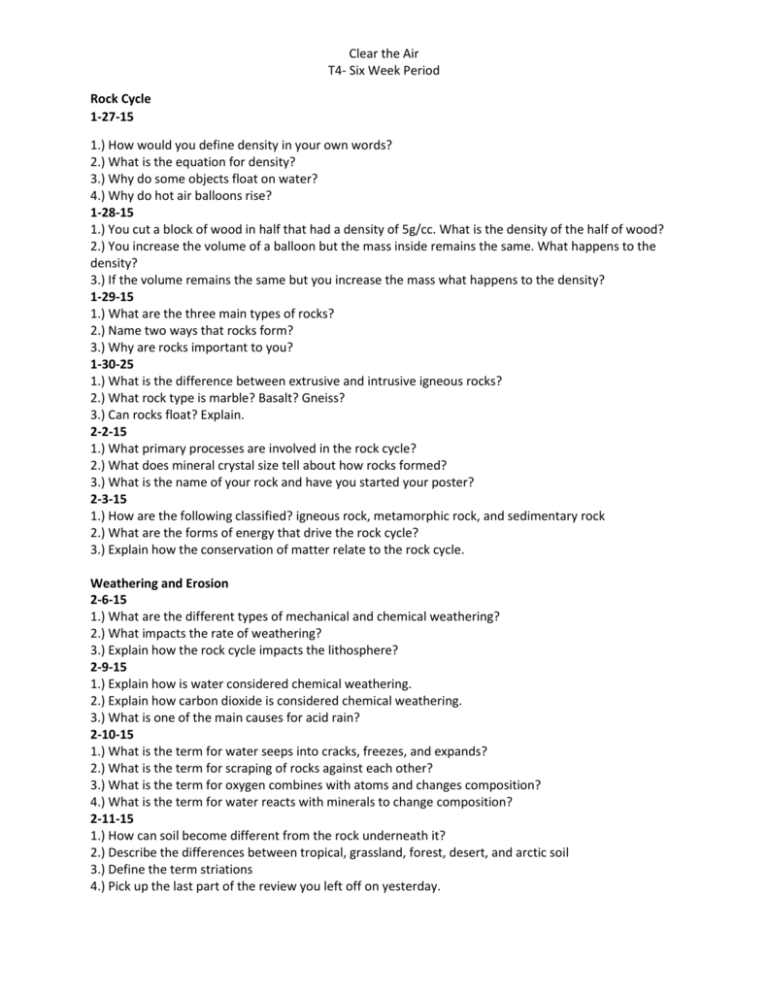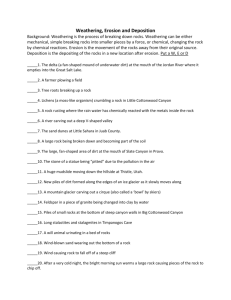Clear the Air
advertisement

Clear the Air T4- Six Week Period Rock Cycle 1-27-15 1.) How would you define density in your own words? 2.) What is the equation for density? 3.) Why do some objects float on water? 4.) Why do hot air balloons rise? 1-28-15 1.) You cut a block of wood in half that had a density of 5g/cc. What is the density of the half of wood? 2.) You increase the volume of a balloon but the mass inside remains the same. What happens to the density? 3.) If the volume remains the same but you increase the mass what happens to the density? 1-29-15 1.) What are the three main types of rocks? 2.) Name two ways that rocks form? 3.) Why are rocks important to you? 1-30-25 1.) What is the difference between extrusive and intrusive igneous rocks? 2.) What rock type is marble? Basalt? Gneiss? 3.) Can rocks float? Explain. 2-2-15 1.) What primary processes are involved in the rock cycle? 2.) What does mineral crystal size tell about how rocks formed? 3.) What is the name of your rock and have you started your poster? 2-3-15 1.) How are the following classified? igneous rock, metamorphic rock, and sedimentary rock 2.) What are the forms of energy that drive the rock cycle? 3.) Explain how the conservation of matter relate to the rock cycle. Weathering and Erosion 2-6-15 1.) What are the different types of mechanical and chemical weathering? 2.) What impacts the rate of weathering? 3.) Explain how the rock cycle impacts the lithosphere? 2-9-15 1.) Explain how is water considered chemical weathering. 2.) Explain how carbon dioxide is considered chemical weathering. 3.) What is one of the main causes for acid rain? 2-10-15 1.) What is the term for water seeps into cracks, freezes, and expands? 2.) What is the term for scraping of rocks against each other? 3.) What is the term for oxygen combines with atoms and changes composition? 4.) What is the term for water reacts with minerals to change composition? 2-11-15 1.) How can soil become different from the rock underneath it? 2.) Describe the differences between tropical, grassland, forest, desert, and arctic soil 3.) Define the term striations 4.) Pick up the last part of the review you left off on yesterday. Clear the Air T4- Six Week Period 2-12-15 1.) Define geohazards and provide examples with respect to weathering and erosion 2.) What is the different between clay, silt and sand? 3.) Describe the texture and composition of an extrusive igneous rock, foliated metamorphic rock, and clastic sedimentary rock. 4.) What is the most common and greatest force of weathering? 2-16-15 1.) Describe the relationship between chemical and mechanical weathering 2.) What are the rates at which weathering is affected by? 3.) Describe the relationships between desert, tropical, polar, and temperate climates 4.) What do you know about the relationship between plate tectonics and earthquakes/volcanoes? 2-20-15 1.) How does the rock cycle relate to plate tectonics? 2.) What can you tell me about the difference between latitude and longitude? 3.) How does latitude and longitude relate to locations on earth? 2-27-15 1.) Is there a relationship between the locations of earthquakes, volcanoes, and mountains? Explain. 2.) What can plotting coordinates on a map tell you about plate tectonics? 3.) List 3 differences between latitude and longitude. 3-3-15/ 3-4-15 1.) Latitude measures or . 2.) Longitude measures or . 3.) Which measurement is always listed first when coordinates are given, latitude or longitude? 4.) 0 ⁰ latitude= 5.) 0 ⁰ longitude= 6.) 0 ⁰N, 180⁰ W= 7.) Coordinates for Washington D.C 8.) Coordinates for Madagascar 9.) Coordinates for Brazil 10.) Coordinates for Papua New Guinea 3-9-15 1.)Who is responsible for the Theory of Continental Drift? 2.) Explain the Theory of Continental Drift using 3 sources of evidence 3.)Who is responsible for the Theory of Seafloor Spreading? 4.) Explain the theory of seafloor spreading with regards to ridges and trenches 3-10-15 1.) What are the mechanisms that are the driving force known as plate tectonics? 2.) Name types of plate boundaries and identify the type of crust that form mountain ranges 3.) Name types of plate boundaries and identify the type of crust that form rift valleys 4.) What technology is available to study the seafloor? 3-11-15 1.) What is the mechanism driving convergent boundaries? 2.) What is the mechanism driving divergent boundaries? 3.) Mariana’s Trench is an example of what type of boundary? 4.) Mid-Atlantic Ridge is an example of what type of boundary? 5.) San Andreas Fault is an example of what type of boundary?








